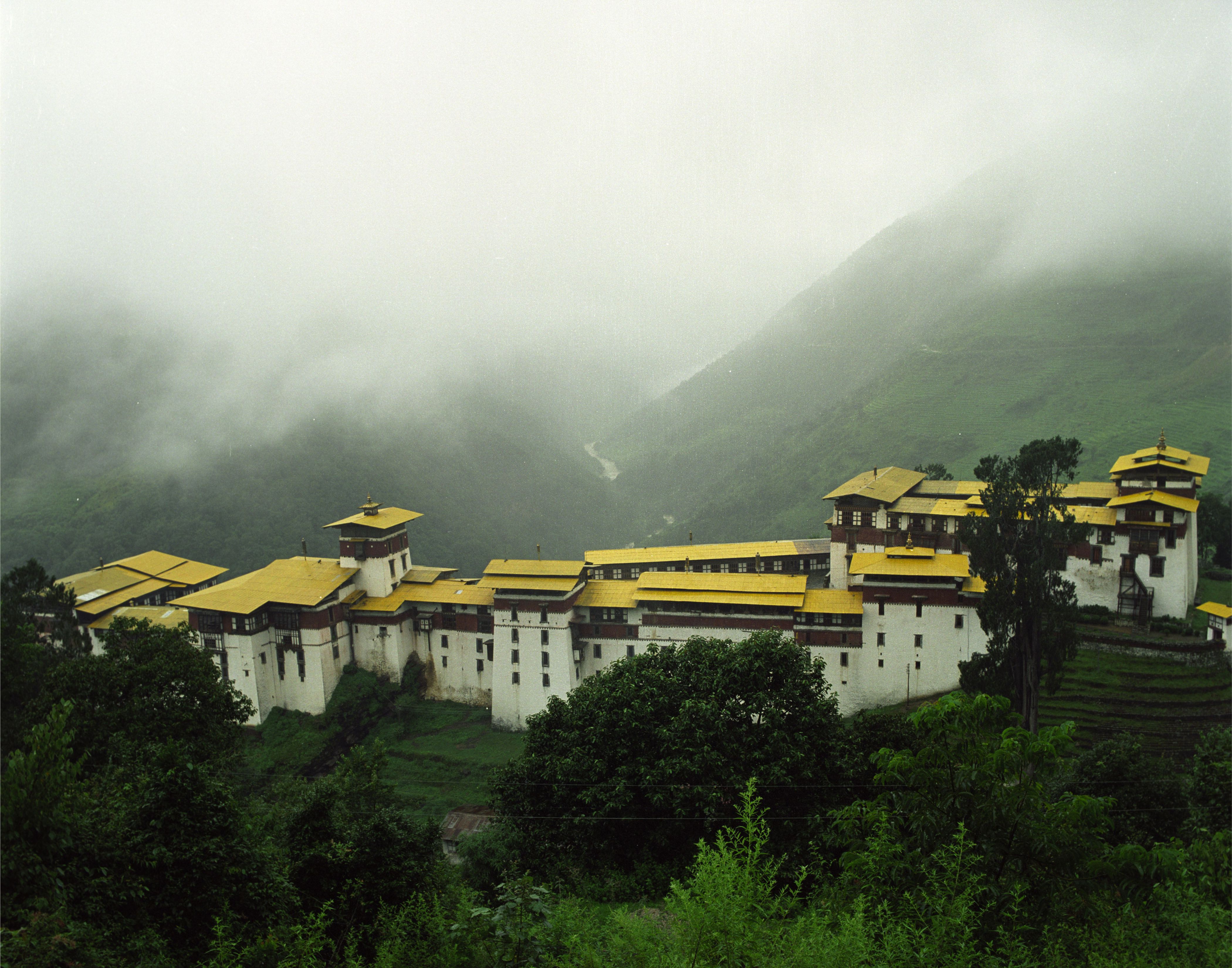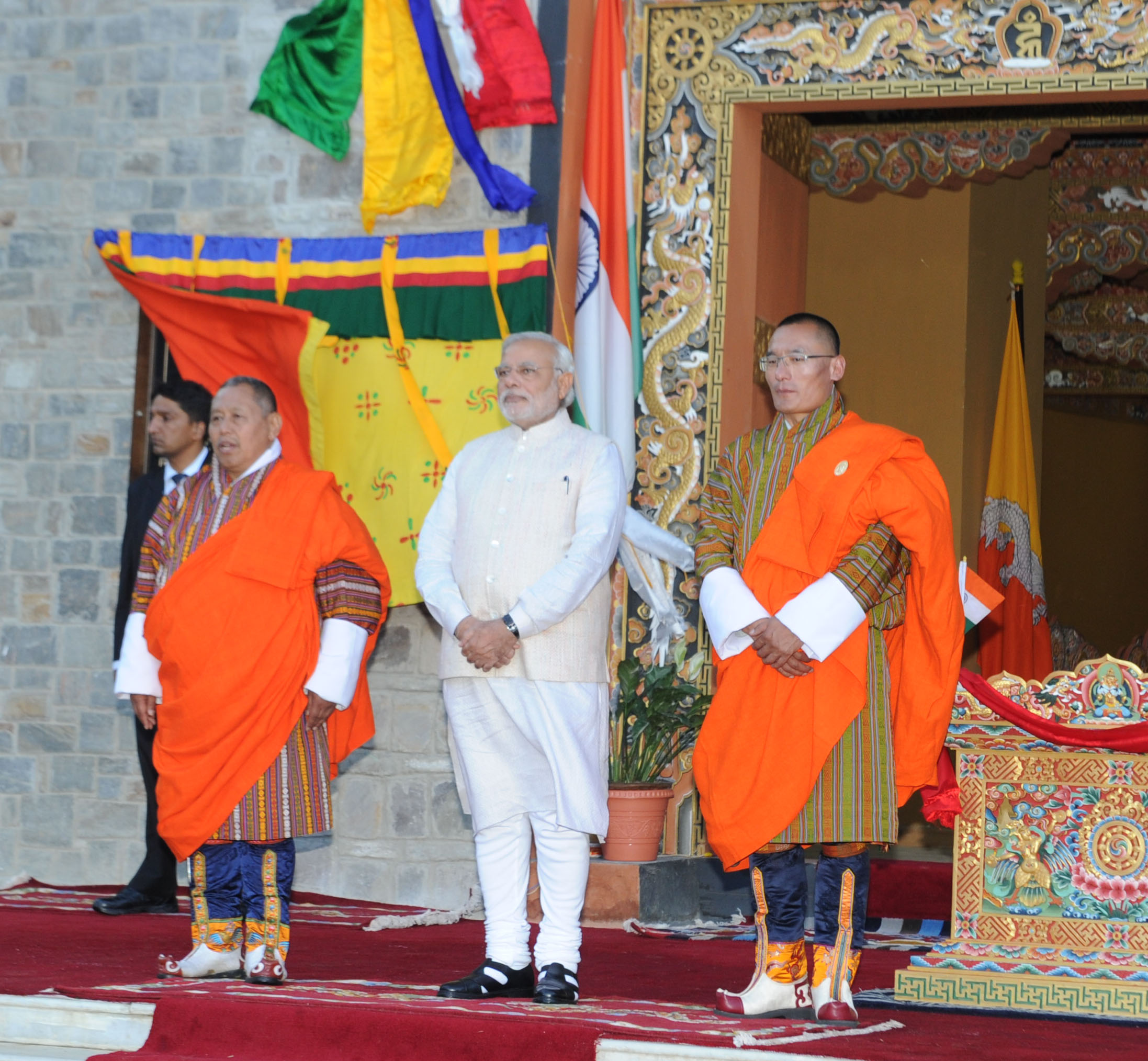|
Jigme Wangchuck
Jigme Wangchuck ( dz, འཇིགས་མེད་དབང་ཕྱུག, ; 1905 – 30 March 1952) was the 2nd Druk Gyalpo or king of Bhutan from 26 August 1926, until his death. He pursued legal and infrastructural reform during his reign. Bhutan continued to maintain almost complete isolation from the outside world during this period; its only foreign relations were with the British Raj in India. He was succeeded by his son, Jigme Dorji Wangchuck. Early life Jigme Wangchuck was born in 1905, at the Thinley Rabten Palace in Wangdue Phodrang District. He received his education at Wangdecholing Palace, where he learned English and Hindi and received a religious education.Lham Dorji, p. 30 As the first son of Ugyen Wangchuck, Jigme was expected to succeed his father; accordingly, he was given the title Penlop of Trongsa in 1923.Lham Dorji, p. 31 Reign Jigme Wangchuck ascended to the throne in 1926, after the death of Ugyen Wangchuck; he received his formal coronation in Puna ... [...More Info...] [...Related Items...] OR: [Wikipedia] [Google] [Baidu] |
Wangdue Phodrang District
Wangdue Phodrang District ( Dzongkha: དབང་འདུས་ཕོ་བྲང་རྫོང་ཁག་; Wylie: ''Dbang-'dus Pho-brang rdzong-khag''; previously spelled "Wangdi Phodrang") is a dzongkhag (district) of central Bhutan. This is also the name of the dzong (built in 1638) which dominates the district, and the name of the small market town outside the gates of the dzong—it is the capital (dzongkhag thromde) of Wangdue Phodrang District). The name is said to have been given by the Shabdrung Ngawang Namgyal who was searching for the best location for a dzong to prevent incursions from the south. The word "wangdue" means unification of Country, and "Phodrang" means Palace in Dzongkha. Wangdue Phodrang is the largest dzongkhag in Bhutan by area and is bordered by Dagana and Tsirang dzongkhags to the south, Tongsa dzongkhag to the east, Thimphu and Punakha dzongkhag to the west, and Gasa dzongkhag and a small section of border with Tibet to the north. It is lis ... [...More Info...] [...Related Items...] OR: [Wikipedia] [Google] [Baidu] |
Order Of The Indian Empire Ribbon
Order, ORDER or Orders may refer to: * Categorization, the process in which ideas and objects are recognized, differentiated, and understood * Heterarchy, a system of organization wherein the elements have the potential to be ranked a number of different ways * Hierarchy, an arrangement of items that are represented as being "above", "below", or "at the same level as" one another * an action or inaction that must be obeyed, mandated by someone in authority People * Orders (surname) Arts, entertainment, and media * ''Order'' (album), a 2009 album by Maroon * "Order", a 2016 song from ''Brand New Maid'' by Band-Maid * ''Orders'' (1974 film), a 1974 film by Michel Brault * ''Orders'', a 2010 film by Brian Christopher * ''Orders'', a 2017 film by Eric Marsh and Andrew Stasiulis * ''Jed & Order'', a 2022 film by Jedman Business * Blanket order, purchase order to allow multiple delivery dates over a period of time * Money order or postal order, a financial instrument usually intende ... [...More Info...] [...Related Items...] OR: [Wikipedia] [Google] [Baidu] |
Maharaja Ugyen Wangchuck Medal
Mahārāja (; also spelled Maharajah, Maharaj) is a Sanskrit title for a "great ruler", "great king" or " high king". A few ruled states informally called empires, including ruler raja Sri Gupta, founder of the ancient Indian Gupta Empire, and Chandragupta Maurya. 'Title inflation' soon led to most being rather mediocre or even petty in real power, which led to compound titles (among other efforts) being used in an attempt to distinguish some among their ranks. The female equivalent, Maharani (or Maharanee, Mahārājñī, Maharajin), denotes either the wife of a Maharaja (or Maharana etc.) or also, in states where it was customary, a woman ruling without a husband. The widow of a Maharaja is known as a Rajmata, "queen mother". Maharajakumar generally denotes a son of a Maharaja, but more specific titulatures are often used at each court, including Yuvaraja for the heir (the crown prince). The form "Maharaj" (without "-a") indicates a separation of noble and religious office ... [...More Info...] [...Related Items...] OR: [Wikipedia] [Google] [Baidu] |
Rinpoche
Rinpoche, also spelled Rimboche and Rinboku (), is an honorific term used in the Tibetan language. It literally means "precious one", and may refer to a person, place, or thing—like the words "gem" or "jewel" (Sanskrit: ''Ratna''). The word consists of ''rin'' (value), ''po'' (nominalizing suffix) and ''chen'' (big). The word is used in the context of Tibetan Buddhism as a way of showing respect when addressing those recognized as reincarnated, older, respected, notable, learned and/or an accomplished Lamas or teachers of the Dharma. It is also used as an honorific for abbots of Buddhist monasteries. See also *Rinpoches, a partial list of a few spiritual teachers of past and present commonly addressed as ''Rinpoche''. *Tulku, someone who is recognized as the rebirth of a previous practitioner of Tibetan Buddhism. *Mount Kailash is often called in the Tibetan language Tibetan language may refer to: * Classical Tibetan, the classical language used also as a contemporary written ... [...More Info...] [...Related Items...] OR: [Wikipedia] [Google] [Baidu] |
Tulku
A ''tulku'' (, also ''tülku'', ''trulku'') is a reincarnate custodian of a specific lineage of teachings in Tibetan Buddhism who is given empowerments and trained from a young age by students of his or her predecessor. High-profile examples of tulkus include the Dalai Lamas, the Panchen Lamas, the Samding Dorje Phagmos, the Karmapas, Khyentses, the Zhabdrung Rinpoches, and the Kongtruls. Nomenclature and etymology The word སྤྲུལ or 'sprul' (Modern Lhasa Tibetan ) was a verb in Old Tibetan literature and was used to describe the བཙན་པོ་ btsanpo ('emperor'/天子) taking a human form on earth. So the ''sprul'' idea of taking a corporeal form is a local religious idea alien to Indian Buddhism and other forms of Buddhism (e.g. Theravadin or Zen). Over time, indigenous religious ideas became assimilated by the new Buddhism; e.g. ''sprul'' became part of a compound noun, སྤྲུལ་སྐུ་'sprul.sku' ("incarnation body" or 'tülku', and 'btsan' ... [...More Info...] [...Related Items...] OR: [Wikipedia] [Google] [Baidu] |
Paro District
Paro District (Dzongkha: སྤ་རོ་རྫོང་ཁག་; Wylie: ''Spa-ro rdzong-khag'') is a district (''dzongkhag''), valley, river and town (population 20,000) in Bhutan. It is one of the most historic valleys in Bhutan. Both trade goods and invading Tibetans came over the pass at the head of the valley, giving Paro the closest cultural connection with Tibet of any Bhutanese district. The dominant language in Paro is Dzongkha, the national language. Paro contains the only international airport in Bhutan, Paro Airport. Geography Paro District is bordered by Haa District to the west, Tibet to the north, Thimphu District to the east, and Chukha District to the south. Administrative divisions Paro Districts comprises ten village blocks (or '' gewogs''): * Doga Gewog * Dopshari Gewog * Doteng Gewog * Hungrel Gewog * Lamgong Gewog * Lungnyi Gewog * Naja Gewog * Shapa Gewog *Tsento Gewog * Wangchang Gewog Environment Northern Paro District (the ''gewogs'' of Dot ... [...More Info...] [...Related Items...] OR: [Wikipedia] [Google] [Baidu] |
Penlop
Penlop ( Dzongkha: དཔོན་སློབ་; Wylie: ''dpon-slob''; also spelled Ponlop, Pönlop) is a Dzongkha term roughly translated as governor. Bhutanese penlops, prior to unification, controlled certain districts of the country, but now hold no administrative office. Rather, penlops are now entirely subservient to the House of Wangchuck. Traditionally, Bhutan comprised nine provinces: Trongsa, Paro, Punakha, Wangdue Phodrang, Daga (also Taka, Tarka, or Taga), Bumthang, Thimphu, Kurtoed (also Kurtoi, Kuru-tod), and Kurmaed (or Kurme, Kuru-mad). The Provinces of Kurtoed and Kurmaed were combined into one local administration, leaving the traditional number of governors at eight. While some lords were penlops, others held the title Dzongpen ( Dzongkha: རྗོང་དཔོན་; Wylie: ''rjong-dpon''; also "Jongpen," "Dzongpön"), a title also translated as "governor." Other historical titles, such as "Governor of Haa," were also awarded. Under the dual syste ... [...More Info...] [...Related Items...] OR: [Wikipedia] [Google] [Baidu] |
Dewangiri
Dewangiri was a northern part of Kamrup, measuring , which was ceded to Bhutan in 1951. The area contains ruins of ancient temples and loose structures. In modern times it lost its earlier importance. It was used only for winter grazing of Bhutanese animals for an annual fee to India before it was ceded to Bhutan.Awadhesh Coomar Sinha, ''Himalayan Kingdom Bhutan'', 2001 See also *Western Assam Lower Assam division is one of the 5 administrative divisions of Assam. It was formed in 1874, comprising Undivided Kamrup district of Western Assam, undivided Darrang and Nagoan districts of Central Assam and Khasi & Jaintia hills of Meghalay ... References {{coord, 26.8665, 91.4646, display=title Kamrup region ... [...More Info...] [...Related Items...] OR: [Wikipedia] [Google] [Baidu] |
Bhutan–India Relations
The bilateral relations between the Himalayan Kingdom of Bhutan and the Republic of India have been traditionally close and both countries share a "special relationship", making Bhutan a protected state, but not a protectorate, of India. India remains influential over Bhutan's foreign policy, defence and commerce. Bhutan is the largest beneficiary of India's foreign aid. Background For much of its history, Bhutan has preserved its isolation from the outside world, staying out of international organizations and maintaining few bilateral relations. Bhutan became a protectorate of British India after signing a treaty in 1910 allowing the British to "guide" its foreign affairs and defence. Bhutan was one of the first to recognize India's independence in 1947 and both nations fostered close relations, their importance augmented by the annexation of Tibet in 1950 by the People's Republic of China and its border disputes with both Bhutan and India, which saw close ties with Bhutan ... [...More Info...] [...Related Items...] OR: [Wikipedia] [Google] [Baidu] |
Partition Of India
The Partition of British India in 1947 was the Partition (politics), change of political borders and the division of other assets that accompanied the dissolution of the British Raj in South Asia and the creation of two independent dominions: Dominion of India, India and Dominion of Pakistan, Pakistan. The Dominion of India is today the India, Republic of India, and the Dominion of Pakistan—which at the time comprised two regions lying on either side of India—is now the Pakistan, Islamic Republic of Pakistan and the Bangladesh, People's Republic of Bangladesh. The partition was outlined in the Indian Independence Act 1947. The change of political borders notably included the division of two provinces of British India, Bengal Presidency, Bengal and Punjab Province (British India), Punjab. The majority Muslim districts in these provinces were awarded to Pakistan and the majority non-Muslim to India. The other assets that were divided included the British Indian Army, ... [...More Info...] [...Related Items...] OR: [Wikipedia] [Google] [Baidu] |
Trongsa
Trongsa, previously Tongsa (, ), is a Thromde or town, and the capital of Trongsa District in central Bhutan. The name means "new village" in Dzongkha. The first temple was built in 1543 by the Drukpa lama Ngagi Wangchuck, who was the great-grandfather of Ngawang Namgyal, Zhabdrung Rinpoche, the unifier of Bhutan. Trongsa Dzong Chökhor Raptentse Dzong at Trongsa which was built in 1644, used to be the seat of power of the Wangchuck dynasty before it became rulers of Bhutan in 1907. Traditionally the King of Bhutan first becomes the Trongsa Penlop (governor) before being named Crown Prince and eventually King. Built on a mountain spur high above the gorges of the Mangde Chhu, the dzong controlled east-west trade for centuries. The only road connecting eastern and western Bhutan (the precursor to the modern Lateral Road), passed through the courtyard of the dzong. At the command of the ''penlop'' the massive doors could be shut, dividing the country in two. Higher yet on the ... [...More Info...] [...Related Items...] OR: [Wikipedia] [Google] [Baidu] |




